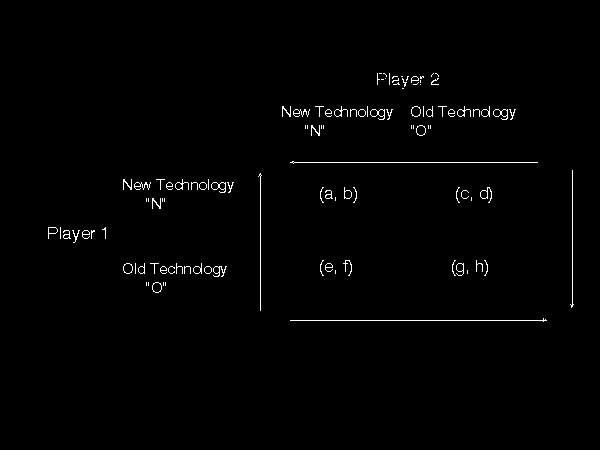
5. Sequential Games
In network markets, and more generally in markets with network externalities, when firms and consumers interact in more than period, history matters. Both consumers and firms make production and consumption decisions based on sizes of installed base and on expectations of its increases over time. The same underlying technology and consumers preferences and distribution can lead to different industrial structures depending on the way things start. Thus, strategic advantages, such as first mover advantages, can have long run effects.33
Network externalities and historical events are particularly important in the speed of adoption of an innovation that creates services on a network. Cabral (1990) discusses the adoption of innovations under perfect competition in the presence of network externalities. His main conclusion is that, when network externalities are strong, the equilibrium adoption path may be discontinuous. This is another way of saying that there are two network sizes supported as equilibria at the same time instant. This may occur at the start of the network, and then it is called positive critical mass by Economides and Himmelberg (1995). It may also occur at other points in the network evolution. In practice, discontinuities in the size of the network over time do not occur since that would imply an infinite size of sales at some points in time. Continuity and smoothness of the network path is restored if instantaneous marginal production costs are increasing. Under this assumption, Economides and Himmelberg (1995) find that the adoption path is much steeper in the presence of externalities. Further, driven by the externality, in early stages the network can expand so quickly as to exhibit increasing retail prices even when marginal costs are falling over time. Their analysis is applied to the FAX market in the US and Japan.
The analysis is more complex when we depart from the assumption of perfect competition. Accordingly, this analysis tends to be in the form of simple two-period models. We analyze it with reference to the standard simultaneous choice coordination game of section 3.2.5, where we now interpret the first strategy as sticking to the old technology, and the second as the adoption of a new one.

Network externalities for both technologies mean that a > c, e; b > d, f; g > c, e; h > d, f. If both firms are worse off when they are not coordinated, both the "New Technology" (i.e., (N, N)) and the "Old Technology" (i.e., (O, O)) will arise as equilibria. Clearly, one of the equilibria can be inefficient. If the (O, O) equilibrium is inefficient and is adopted, Farrell and Saloner (1985) call the situation excess inertia34. Similarly, if the (N, N) equilibrium is inefficient and it is adopted, the situation is called excess momentum.
Farrell and Saloner (1985) discuss a two-period model where consumers have varying willingness to pay for the change of the technology, measured by theta. Users can switch in period 1 or 2, and switching is irreversible. Users fall in four categories according to the strategy they pick: (i) they never switch, whatever the behavior of others in the first period; (ii) they switch in period 2 if other users have switched in period 1 -- jumping on the bandwagon; (iii) they switch in period 1; (iv) switch in period 2 even if others have not switched in period 1. The last strategy is dominated by strategy (iii). Consumers of low theta use strategy (i), consumers of intermediate theta use strategy (ii), and consumers of high theta use strategy (iii). Consumers would like to coordinate themselves and switch in the first period (thereby getting the bandwagon rolling) but are unable to do so, thus creating excess inertia. This inertia can be reduced through communication among the consumers, though contracts, through coordination in committees or through new product sponsorship and special introductory pricing.35 In a sequential setting, preannouncement (i.e., announcement of a new product before its introduction) may induce some users to delay their purchase. Also penetration pricing can be important. Katz and Shapiro (1986a) examine the effects of sponsorship (allowing firms to price differently than at marginal cost). Katz and Shapiro (1986b) examine the effects of uncertainty in product adoption and introduction.
Nevertheless, there is much more work to be done on multiperiod and continuous time dynamic games with network externalities. The issues of foreclosure and predation have not been sufficiently discussed in the context of network externalities. More generally, much more work is required on multiperiod dynamic games in this context, especially for durable goods.